There are countless fictional characters based on real politicians. Huey Long inspired a character in All The King’s Men and Primary Colors features a deft parody of Bill Clinton. But in both these cases, the fiction came second: Clinton and Long were major public figures before they became prominent fictional characters. What happens when the fictional character becomes well known before the politician that the character is based on?

Martin O’Malley is a former Baltimore councilman, a former mayor of Baltimore, the current governor of Maryland, and just possibly a future president of the United States. He’s a liberal governor with a record of accomplishment that seems almost perfectly calibrated for a Democratic presidential primary.
Tommy Carcetti is a fictional Baltimore councilman who first appears in Season 3 of HBO's iconic crime series The Wire. Like O’Malley, he eventually becomes mayor of Baltimore, then governor. He is not a bad guy, exactly; in fact, he’s viewed far more sympathetically than the incumbent mayor he defeats. But Carcetti is changed, and not for the better, when he finally achieves power. Perhaps the biggest transformation is that Carcetti, who runs for office promising to significantly reduce crime in Baltimore, abandons that goal when he reaches City Hall. He realizes that making the city significantly safer would be a long and difficult process—too long and difficult for someone with ambitions to run for governor in two years. Instead, Carcetti adopts a process that he condemned when he ran for office: “juking the stats,” that is, manipulating the number of reported crimes to create the appearance of a reduction in violence.
For many voters, it seems possible that the first thing they will learn about O’Malley may be that he was partly the inspiration for Carcetti. Publications ranging from The New Republic and The American Spectator to The Economist and Entertainment Weekly, have noted the link. When the Maryland governor spoke at the Democratic convention last year, Twitter was filled with snarky jokes from journalists about “Carcetti’s” speech.
One person in particular wouldn’t mind at all if voters draw this parallel: David Simon, The Wire’s creator. Although Simon says that Carcetti was based on several politicians, he sees O’Malley and Carcetti as characterologically linked. “The writing was not unsympathetic to a man who comes in with the idea of changing things and emerges a completely different creature,” Simon told me. “That was the story [of Tommy Carcetti] and that is the story of Marty O’Malley.”
Simon views O’Malley as a politician more interested in promoting himself than engaging in the hard work of governance. His great beef with O’Malley is that, in his view, he also juked the stats on crime—an allegation that O’Malley’s political opponents have also made. The result, in the eyes of The Wire’s creator, “is that O’Malley’s tenure was as destructive a mayoralty to causes of crime and punishment as Baltimore has ever seen and, by that standard, Tommy Carcetti makes him look good.” (Needless to say, all of this is disputed by O’Malley insiders, who brag that, during his tenure, violent crime in Baltimore was cut by nearly 40 percent, down to its lowest levels in decades.)
Simon compares his depiction of Carcetti with Robert Penn Warren’s depiction of Willie Stark—based on Huey Long—in All The King’s Men. In Simon’s opinion, “If Willie Stark existed contemporaneously with excesses of Longism in Louisiana, given the latter years of Longism in Louisiana was a dry run for American dictatorship, the idea that someone would write a work of fiction which would appear contemporaneously [and affect] how people assess the political realities on the ground” would have been a good thing. Instead, Warren’s book came out more than a decade after Long’s death, too late to influence the events and politicians that it fictionalized.
Of course, for this to happen, it’s going to take more than journalists mentioning Carcetti and O’Malley in the same breath—or David Simon touting the parallels between the two. Huge numbers of Democratic voters in Iowa and New Hampshire will need to have some familiarity with The Wire—and at least in Iowa, it’s not clear just how sizeable those numbers are. Carl Wiederaenders, a longtime Iowa Democratic operative, had never even heard of the show; Jeff Link, perhaps the leading Democratic strategist in Iowa, is a fan of The Wire but says he thinks that makes him atypical in the Hawkeye State. Furthermore, Link doubts that anyone in Iowa “puts two and two together” with O’Malley and Carcetti.
Meanwhile, O’Malley’s inner circle says it isn’t worried. “It’s just important to remember that this is all fiction,” says one O’Malley staffer. “It’s not worth getting worked up over fiction that’s produced for people’s entertainment and what really happened in real life. Governor O’Malley is proud of his record and proud of the results he achieved but there’s no concern that people will be less able to distinguish” between fiction and reality.
But if the Carcetti parallel does somehow hurt O’Malley in 2016, it wouldn’t be the first time. The fact that Carcetti has an extramarital affair on The Wire may have helped drive rumors about O’Malley when he first ran for governor in 2006. Whispers flooded Maryland politics that the Baltimore mayor was fooling around. As a Baltimore Sun columnist wrote at the time, “The resemblance between the fictional Councilman Thomas Carcetti and O’Malley has helped fuel the rumor, political observers say.”
But that element of the Carcetti character was entirely made up. “I was in the room when that was invented and I wrote all of that,” says Bill Zorzi, one of the show’s writers. “Part of it was she has to leave her shoes on. It was a little joke because George Pelecanos [another writer for the show and an acclaimed novelist] made his way through college at Maryland selling women’s shoes.” In fact, Zorzi, who covered O’Malley for The Sun, made clear that he never knew of any evidence that the then-mayor fooled around. He was appalled by the smear campaign, and says the “one thing I really do regret” was that the show accidentally contributed to it.
To be sure, for any of this to matter at all, O’Malley will actually have to be a viable candidate. And there’s quite a bit of disagreement in the political world about whether that’s possible. “I think Martin O’Malley is the most oversold stock in the Democratic Party,” says Rick Wilson, a prominent Republican consultant, explaining that the vibe the Maryland governor gives off is “way too considered and deliberate.” Karl Rove has expressed glee about the possibility of the Maryland governor running, dubbing him “the Howard Dean of 2016.” Wiederaenders said few Iowans know who he is: “I’d be surprised if he had 5 percent name ID.”
On the other hand, O’Malley is well liked by the party’s liberal base, and, as Democratic consultant Tad Devine points out, “the primary process is filled with progressive groups, interest groups, and other groups that have a disproportionate voice.” If Devine is right, and O’Malley is in fact able to mount a serious campaign, we will find out soon enough just how far Tommy Carcetti’s shadow extends into the real world.






